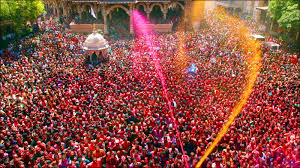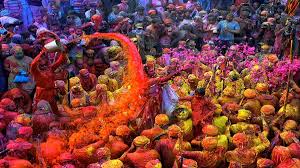Holi, the Festival of Colors, is one of the most vibrant and joyous celebrations in the world. Rooted in ancient Indian traditions, it transcends religious and cultural boundaries, bringing people together in a riot of colors, music, and laughter. Beyond its exuberant exterior, Holi carries profound spiritual, social, and philosophical significance. This article explores the history, rituals, cultural impact, and timeless lessons of Holi, offering a comprehensive understanding of why this festival continues to captivate hearts across the globe.
1. The Origins of Holi: A Blend of Mythology and History
The Legend of Holika and Prahlad
Holi’s origins are deeply intertwined with Hindu mythology, particularly the story of Prahlad and Holika from the Vishnu Purana. Prahlad, a devout follower of Lord Vishnu, was the son of the demon king Hiranyakashipu. Despite his father’s tyranny and attempts to kill him, Prahlad’s unwavering faith protected him.
- Holika’s Deception: Hiranyakashipu’s sister, Holika, tricked Prahlad into sitting on a pyre with her, believing her immunity to fire would kill him. However, divine intervention saved Prahlad, and Holika perished.
- Symbolism: The burning of Holika symbolizes the triumph of good over evil, faith over arrogance, and light over darkness.
The Legend of Radha and Krishna
In the Braj region of India, Holi is celebrated as a tribute to the divine love between Radha and Krishna.
- Playful Colors: Young Krishna, jealous of Radha’s fair complexion, playfully colored her face. This act of love and mischief became the inspiration for the tradition of playing with colors.
- Cultural Significance: The Radha-Krishna legend emphasizes the joy of love, unity, and the breaking of societal barriers.
Historical Roots
Holi’s celebration dates back to ancient times, with references in texts like the Jaimini Mimamsa Sutras and Narada Purana. It was also popularized by medieval poets like Surdas and Kabir, who wove its themes into their devotional works.
2. The Rituals of Holi: A Symphony of Traditions
Holika Dahan: The Bonfire of Renewal
- When: The night before Holi, known as Chhoti Holi.
- What Happens: A bonfire is lit to symbolize the burning of Holika and the destruction of evil.
- Rituals: People offer grains, coconuts, and wood to the fire, sing devotional songs, and perform circumambulations (parikrama).
- Symbolism: The fire represents purification, letting go of past grievances, and starting anew.
Rangwali Holi: The Festival of Colors
- When: The day after Holika Dahan.
- What Happens: People smear each other with gulal (colored powder) and drench each other with pichkaris (water guns).
- Traditional Colors:
- Red: Love and fertility.
- Yellow: Turmeric and health.
- Green: Nature and new beginnings.
- Blue: The divine and Krishna’s complexion.
- Music and Dance: Folk songs (Holi geet) and dances like Lathmar Holi in Barsana add to the festive spirit.
Regional Variations
- Lathmar Holi (Barsana, Uttar Pradesh): Women playfully beat men with sticks, reenacting Radha and Krishna’s playful banter.
- Phoolon ki Holi (Mathura-Vrindavan): Flowers replace colors, creating a serene and fragrant celebration.
- Hola Mohalla (Punjab): A martial arts display by Sikhs, showcasing bravery and community spirit.
- Dol Jatra (West Bengal): Idols of Radha and Krishna are carried in processions, accompanied by devotional songs.
3. The Cultural Impact of Holi: A Global Phenomenon
Unity in Diversity
Holi transcends caste, creed, and religion, bringing people together in a shared celebration of joy. It is a reminder that beneath our external differences, we are all the same.
A Festival of Forgiveness
Holi encourages people to forgive past grievances and start anew. The phrase “Bura na mano, Holi hai!” (Don’t mind, it’s Holi!) embodies this spirit of reconciliation.
Art and Literature
Holi has inspired countless works of art, poetry, and music. From the miniature paintings of Rajasthan to Bollywood songs like “Rang Barse”, its influence is omnipresent.
Global Celebrations
Holi is now celebrated worldwide, from New York to Sydney, as a symbol of multiculturalism and inclusivity. Events like Holi Fest and Color Runs have popularized its essence beyond Indian borders.
4. The Philosophical Lessons of Holi
1. The Triumph of Good Over Evil
The story of Prahlad and Holika reminds us that truth and righteousness always prevail, no matter how powerful evil may seem.
2. The Impermanence of Life
The vibrant colors of Holi symbolize the transient nature of life. Just as colors fade, so do our joys and sorrows, teaching us to live in the present.
3. Breaking Barriers
Holi breaks down social hierarchies, uniting people across age, gender, and class. It is a celebration of equality and inclusivity.
4. Renewal and Rebirth
The burning of Holika and the playing of colors signify the shedding of old habits and the embrace of new beginnings.
5. The Joy of Simplicity
Holi teaches us to find happiness in simple pleasures—colors, music, and the company of loved ones.
5. Modern Challenges and Sustainable Celebrations
Environmental Concerns
- Chemical Colors: Many synthetic colors contain harmful chemicals that damage skin and the environment.
- Water Wastage: Excessive use of water during Holi exacerbates water scarcity in many regions.
Sustainable Practices
- Natural Colors: Use organic, plant-based colors made from turmeric, beetroot, and flowers.
- Water Conservation: Opt for dry Holi or use minimal water.
- Eco-Friendly Celebrations: Avoid plastic and promote eco-conscious practices.
6. Holi in the Modern World: A Timeless Celebration
Holi’s enduring appeal lies in its ability to adapt to changing times while retaining its core values. In a world often divided by differences, Holi serves as a reminder of our shared humanity and the joy of togetherness.
Conclusion: The Eternal Spirit of Holi
Holi is more than just a festival; it is a celebration of life itself. Its colors remind us of the vibrancy of existence, its rituals teach us the importance of renewal, and its stories inspire us to embrace goodness and love. As we celebrate Holi, let us not only revel in its joy but also reflect on its deeper lessons—lessons of unity, forgiveness, and the eternal triumph of light over darkness.
“Bura na mano, Holi hai!” Let the colors of Holi fill your life with happiness, love, and hope.

